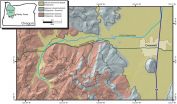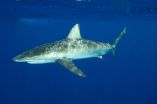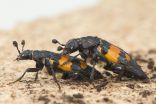(Press-News.org) EUGENE, Ore. -- March 9, 2015 -- University of Oregon geologist Qusheng Jin initially labeled his theory "A Wild Hypothesis." Now his study of arsenic cycling in a southern Willamette Valley aquifer is splashing with potential significance for arsenic-compromised aquifers around the world.
In a paper online ahead of regular publication in the journal Nature Geoscience, Jin's five-member team reports on a bacterial process that turns toxic inorganic arsenic into organic forms that usually are considered to be less dangerous. Jin's conclusion now is that organic arsenic should be monitored.
"No one has touched on the link between arsenic on the surface and in groundwater," said Jin, a professor in the UO Department of Geological Sciences. "Traditionally the presence of the organic form in groundwater has been ignored. The focus has always been on inorganic forms, arsenate and arsenite."
That approach, Jin said, over-simplifies the view on arsenic levels and overlooks how human activities, including pumping and irrigation, or environmental factors such as heavy rain or drought may influence organic forms.
Water is considered safe to drink when total arsenic levels are below 10 micrograms per liter. Levels above that are considered cancer risks.
Arsenic is a natural element found in abundance in the Earth's crust. Organic arsenic, Jin said, is made up of a series of carbon-containing forms. Total arsenic is commonly assumed to be a pure metalloid form. Arsenic often changes forms as it moves through the environment. It also is used in some pesticides, herbicides and wood preservatives and in chicken feed.
The organic arsenic that caught the team's attention is dimethylarsinate (DMA). This intermediate stage is a floating mishmash of dissolved organic forms along with inorganic arsenite and arsenate already floating freely in the water.
DMA's concentration -- sometimes exceeding 10 percent of inorganic arsenic -- always correlates with the overall arsenite level, Jin said. Eventually, he added, the conversion process can turn arsenic into arsine, a volatile gas similar to fluorescent phosphine that rises as the result of decomposition in graveyards.
The fieldwork, led by Jin, involved gathering water samples at depths ranging from 20 to 40 meters (66 to 131 feet) from 23 wells located on rural properties near Creswell, Oregon. In 10 of the wells tested, DMA was found with concentrations as high as 16.5 micrograms per liter.
The aquifer consists of volcanic sandstone, tuff and silicic ash, overlaid by lava flows and river sediments. The basin floor dates to 33 million years ago. Organic arsenic in the aquifer, the researchers noted, is similar to that in aquifers in Florida and New Jersey in the United States and in Argentina, China (Inner Mongolia and Datong), Cypress, Taiwan and West Bengal. Arsenic in groundwater is a challenge worldwide, including all 48 contiguous U.S. states.
To test the hypothesis that arsenic cycling was occurring by way of native bacteria, UO doctoral student Scott C. Maguffin conducted a series of three laboratory experiments involving dissolved arsenite and arsenate taken from wells in the study area. The addition of ethanol in the final experiment stimulated bacterial activity, resulting in DMA concentrations much higher than those found in the field.
"I am concerned about the impact of this cycling process in aquifers," Jin said. "If this process is as important as we believe it is, it will impact the transport and fate of arsenic in groundwater. Many organic arsenic forms are volatile and prone to diffusion. Where will these organic arsenic forms go? Will they ever make to the surface?"
The findings, Jin added, open a window on naturally occurring arsenic cycling and how, eventually, it might be manipulated to treat arsenic-contaminated water. "The cycling is important," he said. "This basic science provides a conceptual framework to understand arsenic behavior in the environment."
INFORMATION:
The National Science Foundation (grant 0810190) to Jin funded the research, which began in 2008. Co-authors with Maguffin and Jin were UO graduate student Ashley R. Daigle, Matthew F. Kirk of Kansas State University and Stephen R. Hinkle of the U.S. Geological Survey in Portland, Oregon.
Source: Qusheng Jin, associate professor, Department of Geological Sciences, 541-346-4999, qjin@uoregon.edu
Note: The University of Oregon is equipped with an on-campus television studio with a point-of-origin Vyvx connection, which provides broadcast-quality video to networks worldwide via fiber optic network. In addition, there is video access to satellite uplink, and audio access to an ISDN codec for broadcast-quality radio interviews.
Links:
Jin faculty page: http://geology.uoregon.edu/profile/qjin/
About Maguffin: http://geology.uoregon.edu/profile/maguffin/
UO Department of Geological Sciences: http://geology.uoregon.edu/
SAN FRANCISCO (March 9, 2015) -- A team of Brazilian scientists--including Luiz Rocha, PhD, Associate Curator of Ichthyology at the California Academy of Sciences--is raising awareness about impending conservation setbacks for Brazil's aquatic animals, calling for immediate fisheries management collaboration between the nation's public and private sectors. The scientists say Brazil can transform this moment of political turmoil into positive action--and become a leader among developing countries facing widespread extinction of aquatic fauna. The call to protect the future ...
Vildagliptin (trade name Galvus or Jalra) has been approved since September 2007 for adults with type 2 diabetes mellitus in whom diet and exercise do not provide adequate glycaemic control. The German Institute for Quality and Efficiency in Health Care (IQWiG) examined in a new dossier assessment whether this drug offers an added benefit over the appropriate comparator therapy. Such an added benefit cannot be derived from the new dossier either, however, because the drug manufacturer did not submit any suitable data.
Manufacturer itself applied for a new dossier assessment
Neither ...
Atomic clocks are the most accurate clocks in the world. In an atomic clock, electrons jumping from one orbit to another decides the clock's frequency. To get the electrons to jump, researchers shine light on the atoms using stabilised laser light. However, the laser light has to have a very precise frequency to trigger very precise electron jumps. It is however challenging to get the laser light frequency ultra precise - there will always be a little 'noise'. Now researchers from the Niels Bohr Institute have developed a method that reduces the noise so that it is up to ...
The drug combination of ledipasvir and sofosbuvir (trade name Harvoni) has been available since November 2014 for the treatment of chronic hepatitis C infection. The German Institute for Quality and Efficiency in Health Care (IQWiG) examined in a dossier assessment whether this new drug offers an added benefit over the appropriate comparator therapy.
IQWiG found a hint a non-quantifiable added benefit for two out of seven patient groups in total: in an infection with genotype 1 hepatitis C virus (HCV) when previous therapies had been unsuccessful, and when previously ...
HEIDELBERG, 10 March 2015 - An international group of researchers has shown that a regulatory protein involved in controlling how cancer spreads through the body also influences the fate of stem cells in the intestine of mice. The results, which are published in The EMBO Journal, show that the Snai1 protein plays an important role in deciding the fate of intestinal stem cells and the different functions that these cells can adopt.
"Our results show that Snai1 is a key regulator of crypt base columnar cells, a type of stem cell found in the invaginations or crypts that ...
New research conducted by The University of Manchester has found that GPs' patients can feel alienated by lack of trust, impersonal processes and that this presents problems to improving their safety.
Most research into patient safety focuses on the systems operated by health services. This is particularly focused on hospitals. However, most encounters occur within GP services where relationships between doctor and patient can form a significant part of reaching successful diagnosis and treatment.
The team from the NIHR Greater Manchester Primary Care Patient Safety ...
Study suggests that millions of modern Asian men are descended from 11 ancient leaders, including Genghis Khan
Sample examined the Y chromosomes of 5,000 Asian men from 127 populations
Historical nomadic and mobile populations allowed for Y chromosomes to be spread far and wide
Geneticists from the University of Leicester have discovered that millions of modern Asian men are descended from 11 powerful dynastic leaders who lived up to 4,000 years ago - including Mongolian warlord Genghis Khan.
The study, which is funded by the Wellcome Trust and published in ...
Males that mate more often are more insecure about their social status than those mating less, according to new research on the behaviour of burying beetles.
The study, published in the journal Evolution, provides new evidence that the social sensitivity of male behaviour is linked to how often male beetles mate.
Male burying beetles actively compete with each other for access to breeding resources such as dead mice, and when they find a suitable carcass will emit pheromones as a signal to attract females. But the emission of pheromones may also attract other males, ...
BUFFALO, N.Y. - Although some children emerge from cold and neglectful family environments as adults with high self-esteem, a new University at Buffalo study suggests these people may still be at a relative disadvantage in life, with a foggier sense of who they are.
On the other hand, adults with low self-esteem who grew up in the same type of negative environment actually have relatively high self-clarity, according to the study's findings.
"Our findings show that even those people who manage to get out of that relatively negative time and view themselves as good, worthwhile ...
Berkeley -- When University of California, Berkeley, bioengineers say they are holding their hearts in the palms of their hands, they are not talking about emotional vulnerability.
Instead, the research team led by bioengineering professor Kevin Healy is presenting a network of pulsating cardiac muscle cells housed in an inch-long silicone device that effectively models human heart tissue, and they have demonstrated the viability of this system as a drug-screening tool by testing it with cardiovascular medications.
This organ-on-a-chip, reported in a study to be published ...





